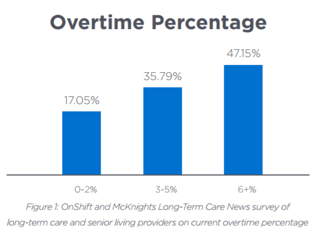May 25, 2017 | Peter Corless
May 25, 2017 | Peter Corless
 Labor costs have reached unprecedented heights due to high turnover and a growing workforce shortage. This has led senior care providers to accept paying a premium for labor through increased use of agency staff and overtime. In fact, overtime typically accounts for 6-8% or more of a provider’s labor cost.
Labor costs have reached unprecedented heights due to high turnover and a growing workforce shortage. This has led senior care providers to accept paying a premium for labor through increased use of agency staff and overtime. In fact, overtime typically accounts for 6-8% or more of a provider’s labor cost.
Given the current reimbursement rate and tight margins, your organization can't afford to flush away that excess labor spend. Although overtime may not be realistic to eliminate, it can be controlled—if you get ahead of it. Consider that just a 1% reduction to a community’s overtime rate can save $24,000- $60,000 annually. That’s huge savings.
OnShift works with thousands of providers in post-acute care and senior living to implement proactive processes that prevent overtime before it occurs. Here are 4 steps you can take that are critical to reducing overtime:
 1. Set & Communicate Realistic Overtime Goals: Obviously eliminating overtime would be ideal, but that’s not realistic. Identify what is causing the unnecessary overtime and set a goal that is achievable. Once established, communicate that goal to your schedulers, as they are your greatest asset in assuring that goal is met. We recommend communicating your overtime goal in number of hours, so that schedulers have a clear understanding and can easily track any decreases (or increases) in a concrete way. Once set, managers and schedulers should meet regularly to discuss progress and reevaluate goals.
1. Set & Communicate Realistic Overtime Goals: Obviously eliminating overtime would be ideal, but that’s not realistic. Identify what is causing the unnecessary overtime and set a goal that is achievable. Once established, communicate that goal to your schedulers, as they are your greatest asset in assuring that goal is met. We recommend communicating your overtime goal in number of hours, so that schedulers have a clear understanding and can easily track any decreases (or increases) in a concrete way. Once set, managers and schedulers should meet regularly to discuss progress and reevaluate goals.
2. Proactively Identify Overtime: Managing overtime by analyzing past pay period performance is a common mistake. To reduce overtime, it’s critical to be proactive—not reactive—in your approach. This begins with the scheduling processes. Manual scheduling doesn’t provide the insight into potential overtime as adjustments are made—like replacing a call-off. To be effective, schedulers need to be alerted of potential overtime (hours worked + hours scheduled) at the point of scheduling employees. Leveraging employee scheduling software like OnShift allows schedulers to easily identify staff members at risk of incurring overtime and help them find a more cost-effective replacement.
3. Keep Tabs on Clock-Riders: Providing high quality care is the top priority for all post-acute care providers. For caregivers, it can be difficult to start or end a shift exactly as scheduled. Residents’ needs don’t always line up to those parameters. But sometimes, employees punch-in early and punch-out late to “ride-the-clock” and get an extra 15-30 minutes per shift added to their paycheck. To identify potential “clock-riders” compare punch reports against staff schedules to determine variances. This will allow you to have a discussion with those employees and/or their managers to determine why they came in early or stayed late. You’ll notice employee behavior start to change simply because they know you’re tracking their actions.
4. Create a Call-off Plan of Attack: It happens far too often and typically with little notice—someone can’t work. Regardless of the reason, the situation puts the organization, particularly the scheduler, in a bind to fill that shift. More often than not, schedulers will rely on a select few staff members to fill the shift—frequently resulting in overtime. Curb the stress and excess cost associated with call-offs by implementing a process schedulers can use to best fill those shifts by:
But of course, this is easier said than done in the heat of the moment. That’s why OnShift automates this process. With OnShift, potential replacements are automatically identified and, with a click of a mouse, schedulers can send available staff members a message (via text, email, automated phone call or through Onshift’s mobile app) letting them know a shift is available. OnShift then gathers each employee response and identifies the best-fit replacement, helping schedulers make the most cost-effective choice.
Significant overtime reduction is achievable with proactive and predictive employee scheduling software. In fact, OnShift Schedule gave Altercare of Ohio the ability to spot and prevent overtime before it happened, significantly reducing overtime across their organization. You can experience similar success by implementing proactive processes and employee scheduling software that stops overtime in its tracks.
Subscribe to the OnShift Blog
Recent Posts
Categories
About Peter Corless
Peter Corless is Executive Vice President of Enterprise Development for OnShift. Peter is a recognized HR leader in post-acute care and is well-known for his achievements at some of the country’s largest post-acute care organizations, including Kindred Healthcare and Genesis HealthCare. As an experienced, chief administrative and human resources officer within these organizations, he developed strategies that reduced turnover, improved recruiting and hiring strategies, and reduced labor costs.
See for yourself why thousands of providers rely on OnShift’s innovative software for recruitment, hiring, workforce management, pay and engagement. Request your personalized demo today.
